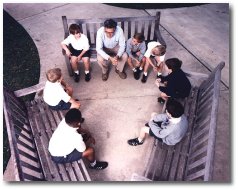

Course
Offerings | Obtain
Adobe� viewer if needed
 The
Lower School Mathematics students learn the four whole-number operations in a step-by-step
approach which seeks to develop mastery by the end of grade four. At each level, students
read and solve word problems using the number operations that they are learning. Place
value, measurement, geometry, fractions, and concepts of numbers are introduced and
reinforced. Considerable use of manipulative objects teaches concepts and reinforces
understanding. In first grade, addition and subtraction are introduced, and the concept of
place value is taught. This work is extended during second grade with the introduction of
regrouping in two-digit subtraction and three-digit addition. Multiplication is introduced
in second grade. In third grade, multiplication and division are emphasized, including the
multiplication and division facts, long division with remainders, and two-digit
multiplication. In fourth grade, the emphasis is on complete mastery of all whole number
theory which has received attention throughout the curriculum, in grades one through four.
The
Lower School Mathematics students learn the four whole-number operations in a step-by-step
approach which seeks to develop mastery by the end of grade four. At each level, students
read and solve word problems using the number operations that they are learning. Place
value, measurement, geometry, fractions, and concepts of numbers are introduced and
reinforced. Considerable use of manipulative objects teaches concepts and reinforces
understanding. In first grade, addition and subtraction are introduced, and the concept of
place value is taught. This work is extended during second grade with the introduction of
regrouping in two-digit subtraction and three-digit addition. Multiplication is introduced
in second grade. In third grade, multiplication and division are emphasized, including the
multiplication and division facts, long division with remainders, and two-digit
multiplication. In fourth grade, the emphasis is on complete mastery of all whole number
theory which has received attention throughout the curriculum, in grades one through four.
The Middle School Mathematics
program’s primary aim is to develop number-sense skills, problem-solving techniques,
and the ability to see and to describe numerical and geometric patterns and relationships.
Beginning with Computations and Concepts in grade 5, students are helped to start
construction of the bridge that connects the concrete world of arithmetic to the abstract
world of algebra. Student participation in class activities and discussion is encouraged
as is the development of good communication skills. Many students will be ready to take
Algebra I in the 8th grade, but others will not yet be ready for the necessary
abstraction. The course sequence allows students to develop mathematical maturity at
different paces and yet arrive at the common goal of completing the bridge to the abstract
with the same level of competence. Students in grades five and six will use the TI-30
series of scientific calculators to explore interesting numerical patterns and to enable
them to solve realistic applied problems. Students in grade seven (beyond Mathematical
Transitions) will be issued a TI-83 graphing calculator in their mathematics class at the
beginning of the school year, and they should bring them to class daily. All eighth grade
students returning to St. Mark’s for the 2001-2002 school year are required to bring
their school issued TI-83 graphing calculator to each class period. New eighth grade
students will be issued a TI-83 calculator in their mathematics class at the beginning of
the school year, and they should bring them to class daily. In the Spring, the department
will make recommendations regarding each boy’s course selection for the following
year. The Mathematics Department makes recommendations based upon what would be the best
course for the students. Thus, the students are expected to enroll in that course.
Enrollment in an honors section is approved by the Department Chair.
The Upper School Mathematics courses seek
to develop skills and concepts which will enable students to analyze and solve problems
from a wide range of mathematical areas, including algebra, geometry, probability, and the
standard elementary (polynomial, rational, trigonometric, logarithmic, and exponential)
functions. Emphasis is placed on active student participation in all aspects of the
learning process. Other goals include the development of logical and critical thinking, of
competence in the use of language and symbols, and of the ability to communicate clearly.
Appropriate technology will be used to explore mathematical concepts and to allow a rich
array of applied problems.
Students must complete the required
sequence of mathematics courses through Algebra II before graduation, and must take
mathematics courses through their junior year, but they are encouraged to continue their
study of mathematics through the senior year. The department offers a variety of electives
to meet the needs and interests of students who complete the Algebra II course before the
end of the junior year. Each spring the department will make recommendations as to
appropriate course selections for students wishing to take an elective and/or an honors
level course. The Mathematics Department makes recommendations based upon what would be
the best course for the students. Thus, the students are expected to enroll in that
course. Enrollment in an honors section is approved by the Department Chair.
All students returning to St. Mark’s
for` the 2001-2002 school year are required to bring their school issued TI-83 graphing
calculator to each class period. New Upper School students will be issued a calculator in
their mathematics class at the beginning of the school year, and they should bring them to
class daily.
Geometry students will use a class set of
TI-92 for instructional purposes.